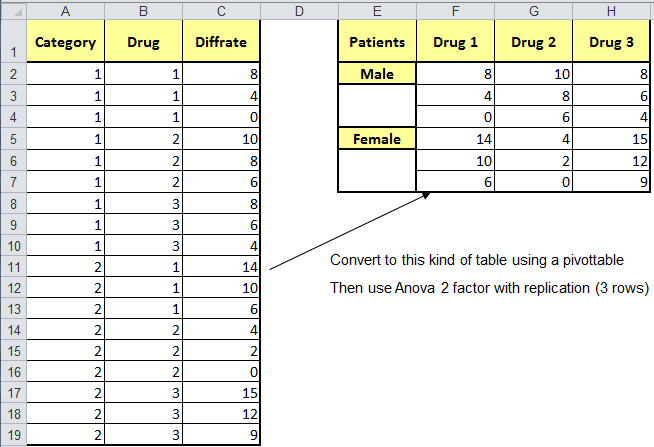
- #How to set up a two way anova in excel how to#
- #How to set up a two way anova in excel software#
- #How to set up a two way anova in excel series#
- #How to set up a two way anova in excel free#
If the p value is less than 0.05, it means that the source of variation has a significant impact on the results. This is the column we want to examine first. Note that there is an additional column in this output – the p values.

The results for the ANOVA table are shown below.

The data was analyzed using the SPC for Excel software. It is based on the ratio of two variances (or mean squares in this case). This is the statistic that is calculated to determine if the source of variability is statistically significant. We will use the mean square information to estimate the variance of each source of variation – this is the key to analyzing the Gage R&R results.

So, the mean square is the sum of squares divided by the degrees of freedom. The mean square is the estimate of the variance for that source of variability (not necessarily by itself) based on the amount of data we have (the degrees of freedom). The fourth column is the mean square associated with the source of variation. The calculations with these two columns were covered in the first part of this series. The second column is the degrees of freedom associated with the source of variation. There are five sources of variability in this ANOVA approach: the operator, the part, the interaction between the operator and part, the equipment and the total. Remember that a Gage R&R study is a study of variation. The first column is the source of variability. The basic ANOVA table is shown in the table below for the following where k = number of operators, r = number of replications, and n= number of parts.
#How to set up a two way anova in excel software#
The software usually displays the results in an ANOVA table. This helps understand the process better. Since this is a relatively simple Gage R&R, we will show how the calculations are done. In most cases, you will use computer software to do the calculations. The data we are using are shown in the table below. The variation due to operators is called the reproducibility. An interaction can exist if the operator and parts are not independent. The variation in all results includes the equipment variation, the part variation, the operator variation and the interaction between operators and parts. Operator 2 and 3 also test the same 5 parts three times each. The variation in those results includes the variation due to the parts as well as the equipment variation. Operator 1 also runs Parts 2 through 5 three times each. It is also called the equipment variation in Gage R&R studies or just with the “within” variation in ANOVA studies. The variation in these three trials is a measure of the repeatability. The operator is the same and the part is the same. What are the sources of variation in these three trials? It is the measurement equipment itself. In the figure above, you can see that Operator 1 has tested Part 1 three times. Operator 1 tested each 5 parts three times.

A partial picture of the Gage R&R design is shown below. In this example, there were three operators who tested five parts three times.
#How to set up a two way anova in excel how to#
This newsletter also explains how to set up a gage R&R study. We are using the data from our December 2007 newsletter on the average and range method for Gage R&R.
#How to set up a two way anova in excel free#
In this issue we will complete the ANOVA table and show how to determine the % of total variance that is due to the measurement system (the % GRR).Īs always, please feel free to leave a comment at the bottom newsletter. Many people do not understand how the calculations work and the information that is contained in the sum of squares and the degrees of freedom. We took an in-depth look at how the sum of squares and degrees of freedom were determined.
#How to set up a two way anova in excel series#
The first part of this series focused on part of the ANOVA table. With the ANOVA method, we will break down the variance into four components: parts, operators, interaction between parts and operators and the repeatability error due to the measurement system (or gage) itself. The two methods do not generate the same results, but they will (in most cases) be similar. This method simply uses analysis of variance to analyze the results of a gage R&R study instead of the classical average and range method. This month's newsletter is the second in a multi-part series on using the ANOVA method for a Gage R&R study.


 0 kommentar(er)
0 kommentar(er)
